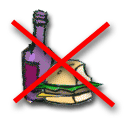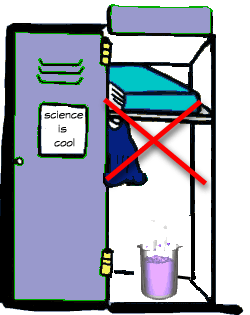
CATEGORIES:
BiologyChemistryConstructionCultureEcologyEconomyElectronicsFinanceGeographyHistoryInformaticsLawMathematicsMechanicsMedicineOtherPedagogyPhilosophyPhysicsPolicyPsychologySociologySportTourism
READING COMPREHENSION
12 Study the text Lab Safety Rules and underline the expressions you are not familiar with. Can you guess their meaning from the context? If not, consult the dictionary.
13 Did any of the rules surprise you?
|
TEAM WORK
14 Work in pairs or small groups and decide which of the rules are of the utmost importance. Make a TOP TEN list and reason your choice. Then report to the rest of the class.
15 Make a summary of the most important laboratory safety rules concerning the following facts:
- dress code for a laboratory worker
- refreshment during the lab period
- working with chemicals
- working with hot glassware
- what to do in case of injury
- what to do in case of fire
16 Read the Chemistry Poem. Do you know any poem, joke or anecdote about chemists, chemistry or labs?
Chemistry Poem
Poor Willie worked in chem lab. Poor Willie is no more.
For what he thought was H2O was H2SO4!
FOLLOWING INSTRUCTIONS
17 Read the instructions on how to produce aspirin.
How to Make Aspirin - Acetylsalicylic Acid - Introduction and History
1. Accurately weigh 3.00 grams of salicylic acid and transfer to a dry Erlenmeyer flask. If you calculate actual and theoretical yield, be sure to record how much salicylic acid you actually measured.
2. Add 6 mL of acetic anhydride and 5-8 drops of 85% phosphoric acid to the flask.
3. Gently swirl the flask to mix the solution. Place the flask in a beaker of warm water for 15 minutes.
4. Add 20 drops of cold water dropwise to the warm solution to destroy the excess acetic anhydride.
5. Add 20 mL of water to the flask. Set the flask in an ice bath to cool the mixture and speed crystallization.
6. When the crystallization process appears complete, pour the mixture through a Buchner funnel.
7. Apply suction filtration through the funnel and wash the crystals with a few milliliters of ice cold water. Be sure the water is near freezing to minimize loss of product.
8. Perform a recrystallization to purify the product. Transfer the crystals to a beaker. Add 10 mL of ethanol. Stir and warm the beaker to dissolve the crystals.
9. After the crystals have dissolved, add 25 mL of warm water to the alcohol solution. Cover the beaker. Crystals will reform as the solution cools. Once crystallization has started, set the beaker in an ice bath to complete the recrystallization.
10. Pour the contents of the beaker into a Buchner funnel and apply suction filtration.
11. Remove the crystals to dry paper to remove excess water.
12. Confirm you have acetylsalicylic acid by verifying a melting point of 135°C.
VOCABULARY
yield - the quantity of a product formed by the interaction of two or more substances
swirl - to move around or along with a whirling motion
excess - the fact of exceeding something else in amount or degree
suction - to draw out or remove by aspiration
loss - something that is lost
confirm - to acknowledge with definite assurance
verify - to prove the truth of, as by evidence or testimony; confirm
18 Make a list of all the items of laboratory equipment you need for this experiment.
19 Match the verbs describing the process with the nouns.
transfer excess water
mix the crystals
remove a funnel
dissolve to a flask
pour through loss of product
minimize the solution
20 Write down the KEY WORDS from each instruction. Then try to cover the text and reconstruct the procedure using your key words.
WRITING
21 Choose one of the experiments you really performed in the laboratory and write down the instructions of the procedure. (minimum: 10 steps)
LEXICAL EXERCISES
22 Look again at the instructions for making aspirin in exercise 17, namely steps 8 and 9 containing the words recrystallization and reform. What is the meaning of the prefix re- in those words?
23 A Use 8 of the following prefixes to fill the gaps.
dis- en- im- inter- mono- nano- pre- semi- ultra- un- micro-
_____cellular space serves for gas to be exchanged between cells.
_____capsulated drugs are used for targeted delivery, i.e. the capsule dissolves and releases its contents when it reaches the required location.
_____tubes have a diameter smaller than 200 x 109 meters.
_____structure is the detailed structure of biological specimen, such as a cell, tissue, or organ, that can be observed by electron _____scopy.
Often it is impossible to _____determine the specific problems that researches will meet during their laboratory work.
_____basic acids, such as HCl or HNO3, are acids that have only one hydrogen ion to donate to a base in an acid-base reaction.
Trans fatty acid is commonly produced by partial hydrogenation of _____saturated fatty acid vegetable oils.
B Explain the meaning of the prefixes.
C Make words with the remaining 3 prefixes and use them in sentences.
24 Work in pairs.
Student A: Fill in table A
Student B: Fill in table B on the Activity Sheet (end of Unit 3)
If you can´t remember anything that would fit in the Example column, your partner will define the word for you to guess.
Table A
| Prefix | Meaning | Example | Prefix | Meaning | Example |
| a-/an- | asymmetric | milli- | 1/1000 | ||
| auto- | self | mono- | monocellular | ||
| bi- | bisulfate | multi- | Many | ||
| bio- | living | re- | reset | ||
| co- | cooperate | semi- | Half | ||
| hydro- | water | tri- | tripod | ||
| kilo- | kilogram | ultra- | Very | ||
| micro- | small | un- | unknown |
25 Study the Common Affixes section of the Grammar File.
26 Fill in the table:
| Noun | Verb |
| Preparation | to prepare |
| Determination | |
| Modification | |
| Application | |
| Condensation | |
| Adsorption | |
| Filtration | |
| to dissolve | |
| to analyse | |
| to observe | |
| to heat | |
| Cold | |
| Change | |
| to spill | |
| Comparison | |
| Synthesis | |
| Identification | |
| Degradation |
Date: 2015-01-12; view: 4596
| <== previous page | | | next page ==> |
| LABORATORY | | | SEARCHING FOR AND SHARING INFORMATION |



 CLOTHING
CLOTHING

 ACCIDENTS AND INJURIES
ACCIDENTS AND INJURIES
 HANDLING CHEMICALS
HANDLING CHEMICALS
